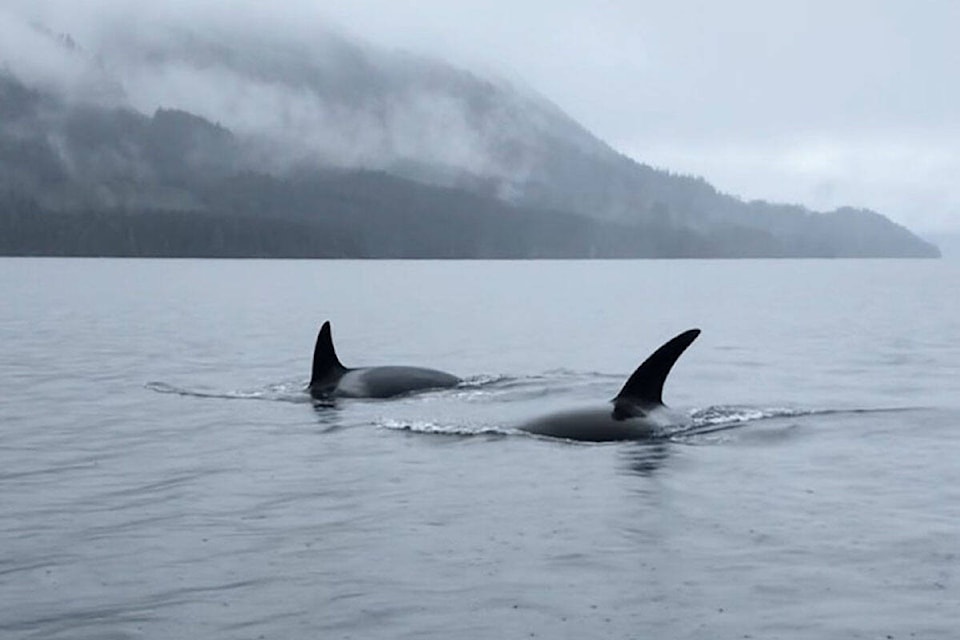Written by Debra Lynn
On a calm and cloudy Christmas Eve last year, at around 10:30 a.m., Quatsino resident Alan Johnson was in his home preparing for an unexpected quick trip down-Island.
When he looked out his window, he saw a humpback whale cruising east to west about 300 feet off the beach. He didn’t make too much of it because he often sees whales from his house on a point at the western end of Quatsino village, located on the northwest corner of Vancouver Island.
Five minutes later, as he headed to the wharf to get on his boat, he noticed “all this commotion” on the water.
Johnson saw three killer whales “in a frenzy in one area.” He added, they were “coming partially out of the water, diving down, partially out of the water, diving down.”
He then noticed that a humpback was part of the commotion. He saw the humpback was on its side, just barely above water. A flipper came up and it sank under the surface while “these three killer whales were just right on top of it.”
He said it was hard to see clearly, because “there was so much churning and foam and everything” and that there were no pauses or delays.
“It was very intense. I mean, there was no slacking off with these,” because as soon as they came out of the water, they were “Bang! Back down on top!”
While the two smaller killer whales kept attacking the humpback from the side, the largest orca—which he describes as one of the largest he’s ever seen — would breach straight up and then fall straight down on the humpback. This happened about four or five times.
“I would suggest that they were just trying to force it down into the water,” Johnson said, speculating the whales’ whole plan may have been to drown the humpback.
Johnson watched the scene for 15 or 20 minutes but had to leave. His wife, Heather, continued to watch from their house for another fifteen minutes. She says she saw the flipper of the humpback a couple more times and then, “everything went quiet, absolutely quiet.”
There was no sign of the humpback or the killer whales thereafter.
Although Johnson has seen plenty of whales in his life, this was the first time he has seen a whale-on-whale encounter.
“It’s one of those things that you…go through a lifetime without ever seeing, it even if you were on the water all the time.”
Expert Analysis by The Marine Detective Jackie Hildering
When contacted by the Gazette, Jackie Hildering, a humpback whale researcher from the area’s Marine Education and Research Society (MERS), provided the following insights, requesting that her comments be published in full:
“We have records of over 60 interactions between humpbacks and both resident (fish-eating) and Bigg’s killer whales (mammal-eating).
“While it is certainly possible that a humpback could be killed by Bigg’s killer whales, especially if young, injured, and/or skinny at the beginning of the feeding season, to date there is no confirmed death of a humpback whale being killed off our coast. It is important to realize that humpbacks are formidable.
“They are ‘fight whales.’ Instead of trying to flee such encounters like faster baleen whales, they typically hold their ground, and even advance toward the orcas. This can lead to VERY intense interactions as described by Alan and Heather.
“What would be needed to confirm a death is photos showing which humpback whale was involved in the interaction and that whale’s body. Even for a humpback who comes back to feed in a specific area year after year, if that whale does not return, it is not conclusive that the whale died. The whale could be somewhere else.
“In the intense interactions we (MERS) have witnessed, and where we were able to identify which humpback(s) were involved, the humpbacks survived. One humpback whale, Freckles, has even been documented in intense interactions more than 10 times. Other humpbacks have scars (rake marks) from the teeth of killer whales, as a testament to surviving attacks.
“Considerations in striving to interpret what Alan and Heather witnessed too are the size of most humpbacks at this time of year, and that ‘everything went quiet.’
“After Bigg’s killer whales make a kill, they very often ‘mill’ at the surface, socializing near the kill. We cannot know, but the interaction may have continued underwater and out of the range of what could be witnessed. Further clues about kills can be that when killer whales bite into blubber, a slick of oil appears at the surface and birds often take an interest in scraps.
“Note that it is normal for humpback whales to be alone and still off our coast in the winter. Some leave much later for the migration.
“All this underlines the great value of eyes on the water such as Alan and Heather’s and in knowing who the whales are through the submission of photos taken outside 200 metres.
“This is a valued puzzle piece that may allow for further interpretation and understanding in the future.”
For more information, visit the .
Have a story tip? Email: editor@northislandgazette.com
Like us on and follow us on .



